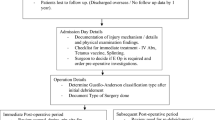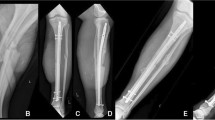Abstract
Introduction
It was the goal of this study to determine if the Orthopaedic Trauma Association Open Fracture Classification (OTA-OFC) correlates with complication rates and to determine if it can be used as a predictive tool in the treatment of open tibial shaft fractures.
Materials and methods
Retrospective review from two high-volume level 1 trauma centers of open tibial shaft fractures over a 5 year period. Variables of interest included OTA-OFC, type of wound closure, 90-day wound complication, unplanned re-operation, non-union, and amputation.
Results
501 consecutive open tibial shaft fractures. 57.3% (n = 287) were closed primarily; local soft tissue advancement/rotational flap was used in 9.6% (n = 48); free soft tissue transfer used in 22.8% (n = 114); 8.6% (n = 43) required amputation. Of those followed for 90 days (n = 419), 45 (9.0%) had a wound complication, of which 40 (8%) required an unplanned reoperation. 40 (8.0%) patients went on to a documented non-union. All OTA-OFC classification groups significantly correlated with type of definitive closure (r = 0.18–0.81, p < 0.05) with OTA-OFC skin showing the strongest correlation (r = 0.81). OTA-OFC bone loss weakly correlated with wound complication (r = 0.12, p = 0.02) and no OTA-OFC classification correlated with the need for an unplanned secondary procedure. OTA-OFC skin, muscle and arterial all weakly correlated with non-union (r = 0.18–0.25, p < 0.05). OTA-OFC muscle was predictive of non-union (OR = OR = 2.2, 95% CI = 1.2–4.1) and amputation (OR 9.3, 95% CI = 3.7–23.7). OTA-OFC arterial was also predictive of amputation (OR 4.8, 95% CI = 2.5–9.3).
Conclusions
The OTA-OFC correlates variably with the type of definitive closure, the development of a 90-day wound complication, and the occurrence of a non-union. Importantly, OTA-OFC muscle classification is predictive of non-union while both OTA-OFC muscle and arterial were predictive of amputation.
Similar content being viewed by others
References
Bone LB, Kassman S, Stegemann P, France J (1994) Prospective study of union rate of open tibial fractures treated with locked, unreamed intramedullary nails. J Orthop Trauma 8(1):45–49. https://doi.org/10.1097/00005131-199402000-00010
Khatod M, Botte MJ, Hoyt DB, Meyer RS, Smith JM, Akeson WH (2003) Outcomes in open tibia fractures: relationship between delay in treatment and infection. J Trauma 55(5):949–954. https://doi.org/10.1097/01.TA.0000092685.80435.63
Harley BJ, Beaupre LA, Jones CA, Dulai SK, Weber DW (2002) The effect of time to definitive treatment on the rate of nonunion and infection in open fractures. J Orthop Trauma 16(7):484–490. https://doi.org/10.1097/00005131-200208000-00006
Fong K, Truong V, Foote CJ, Petrisor B, Williams D, Ristevski B, Sprague S, Bhandari M (2013) Predictors of nonunion and reoperation in patients with fractures of the tibia: an observational study. BMC Musculoskelet Disord 14:103. https://doi.org/10.1186/1471-2474-14-103
Enninghorst N, McDougall D, Hunt JJ, Balogh ZJ (2011) Open tibia fractures: timely debridement leaves injury severity as the only determinant of poor outcome. J Trauma 70(2):352–356. https://doi.org/10.1097/TA.0b013e31820b4285 (discussion 6–7)
Templeman DC, Gulli B, Tsukayama DT, Gustilo RB (1998) Update on the management of open fractures of the tibial shaft. Clin Orthop Relat Res 350:18–25
Giannoudis PV, MacDonald DA, Matthews SJ, Smith RM, Furlong AJ, De Boer P (2000) Nonunion of the femoral diaphysis. The influence of reaming and non-steroidal anti-inflammatory drugs. J Bone Joint Surg Br 82(5):655–658. https://doi.org/10.1302/0301-620x.82b5.9899
Gaston P, Will E, Elton RA, McQueen MM, Court-Brown CM (1999) Fractures of the tibia. Can their outcome be predicted? J Bone Joint Surg Br 81(1):71–76
Dailey HL, Wu KA, Wu PS, McQueen MM, Court-Brown CM (2018) Tibial fracture nonunion and time to healing after reamed intramedullary nailing: risk factors based on a single-center review of 1003 patients. J Orthop Trauma 32(7):e263–e269. https://doi.org/10.1097/BOT.0000000000001173
Thakore RV, Francois EL, Nwosu SK et al (2017) The Gustilo-Anderson classification system as predictor of nonunion and infection in open tibia fractures. Eur J Trauma Emerg Surg 43(5):651–656. https://doi.org/10.1007/s00068-016-0725-y
Gustilo RB, Anderson JT (1976) Prevention of infection in the treatment of one thousand and twenty-five open fractures of long bones: retrospective and prospective analyses. J Bone Joint Surg Am 58(4):453–458
Gustilo RB, Mendoza RM, Williams DN (1984) Problems in the management of type III (severe) open fractures: a new classification of type III open fractures. J Trauma 24(8):742–746
Brumback RJ, Jones AL (1994) Interobserver agreement in the classification of open fractures of the tibia. The results of a survey of two hundred and forty-five orthopaedic surgeons. J Bone Joint Surg Am 76(8):1162–1166
Group OTAOFS (2010) A new classification scheme for open fractures. J Orthop Trauma 24(8):457–464. https://doi.org/10.1097/BOT.0b013e3181c7cb6b
Agel J, Rockwood T, Barber R, Marsh JL (2014) Potential predictive ability of the orthopaedic trauma association open fracture classification. J Orthop Trauma 28(5):300–306. https://doi.org/10.1097/BOT.0b013e3182a70f39
Johnson JP, Karam M, Schisel J, Agel J (2016) An evaluation of the OTA-OFC system in clinical practice: a multi-center study with 90 days outcomes. J Orthop Trauma 30(11):579–583. https://doi.org/10.1097/BOT.0000000000000648
Hao J, Cuellar DO, Herbert B et al (2016) Does the OTA open fracture classification predict the need for limb amputation? A retrospective observational cohort study on 512 patients. J Orthop Trauma 30(4):194–198. https://doi.org/10.1097/BOT.0000000000000479
Agel J, Evans AR, Marsh JL et al (2013) The OTA open fracture classification: a study of reliability and agreement. J Orthop Trauma 27(7):379–384. https://doi.org/10.1097/BOT.0b013e3182820d31 (discussion 84–5)
Marsh JL, Slongo TF, Agel J et al (2007) Fracture and dislocation classification compendium—2007: orthopaedic trauma association classification, database and outcomes committee. J Orthop Trauma 21(10 Suppl):S1-133
O’Halloran K, Coale M, Costales T et al (2016) Will my tibial fracture heal? Predicting nonunion at the time of definitive fixation based on commonly available variables. Clin Orthop Relat Res 474(6):1385–1395. https://doi.org/10.1007/s11999-016-4821-4
Aljawadi A, Islam A, Jahangir N et al (2021) One-stage combined “fix and flap” approach for complex open Gustilo-Anderson IIIB lower limbs fractures: a prospective review of 102 cases. Arch Orthop Trauma Surg. https://doi.org/10.1007/s00402-020-03705-y
Tan WJ, Kwek EBK (2020) Outcomes after implementation of an open fracture clinical pathway. Arch Orthop Trauma Surg 140(10):1373–1379. https://doi.org/10.1007/s00402-020-03363-0
Funding
Not applicable.
Author information
Authors and Affiliations
Corresponding author
Ethics declarations
Conflict of interest
Dr. Garner receives research funding from (not related to this work) and is a board or committee member for the Orthopaedic Trauma Association. He is also a paid consultant for and receives research funding from Johnson and Johnson, DePuy, Synthes. Dr. Warner is a paid consultant for Johnson and Johnson, DePuy, Synthes. Julie Agel is a board or committee member for the Orthopaedic Trauma Association.
Ethical approval
Institutional Review Board approval was obtained at both institutions.
Informed consent
Not applicable.
Additional information
Publisher's Note
Springer Nature remains neutral with regard to jurisdictional claims in published maps and institutional affiliations.
Rights and permissions
About this article
Cite this article
Garner, M.R., Warner, S.J., Heiner, J.A. et al. Evaluation of the orthopaedic trauma association open fracture classification (OTA-OFC) as an outcome prediction tool in open tibial shaft fractures. Arch Orthop Trauma Surg 142, 3599–3603 (2022). https://doi.org/10.1007/s00402-021-03954-5
Received:
Accepted:
Published:
Issue Date:
DOI: https://doi.org/10.1007/s00402-021-03954-5




